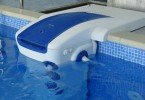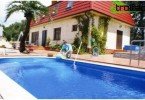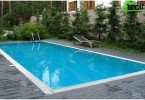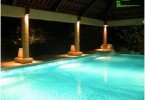How to heat the water in the pool you need to think about at the stage of its design, because all the technological elements of this system are interconnected. Experts recommend installing heating appliances in combination with another pool equipment, but even if such work has not been carried out, the heating system can be integrated later.
It is worth noting that the temperature of water in pools for adults should be at least 24-26 degrees, and for children this parameter has even higher – at least 30 degrees.
Content
- Methods of heating water in an artificial pond
- Flowing electric heaters for small pools
- Heat exchangers – simple economical equipment
- Solar collector (heliosystem)
- Heat pumps: power and speed
Methods of heating water in an artificial pond
There are four ways to heat pool water:
- Flowing electric heaters
- Heat exchangers
- Solar collectors
- Heat pumps
The choice of equipment depends on several factors:
- pool volume
- amount of water for regular heating
- features of communications in the house
- from customer preferences.
So, in order to find out what type of heating equipment will fit most harmoniously into the system of your pool, we will analyze each “by bones”.
Flowing electric heaters for small pools
Flowing electric heaters are the easiest and relatively inexpensive way to heat pool water. They are designed to heat a continuous flow of fluid with the lowest possible pressure drop. This type of heating equipment has a compact size, so for its installation does not require a large technical room. A small indoor booth will be just right.
The case of electric heaters is made of high-quality plastic, titanium or stainless steel, and the heating elements themselves are made of an alloy of stainless steel that can withstand quite high temperatures.
When choosing a flow heater, keep in mind that its power should correspond to the volume of water in the pool: a small and shallow pool located in a heated room does not require the purchase of a large and powerful unit, 3 kW will be enough for it.
Although when it comes to power, flowing electric heaters cannot boast of this parameter – the maximum that they are able to squeeze themselves out is 18 kW, which is clearly not enough for a large outdoor pool. So, if your pool has a volume of more than 36 cubic meters. meters and it is located on the street, the purchase of such equipment will be an unjustified waste of money, because even the most powerful of the model range of electric heaters can not cope with the task.
In addition, the house may have a restriction on energy consumption or the wiring does not meet all the requirements, then it makes no sense to install such a unit.
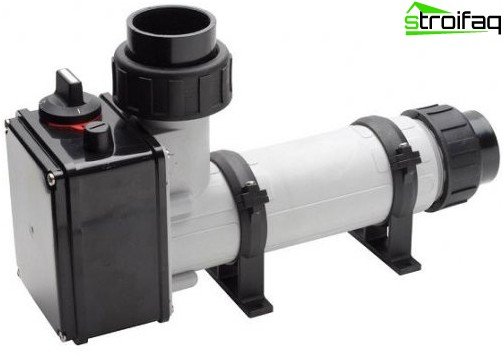
Instantaneous electric heater – great for a small pool
Advantages of instantaneous electric heaters:
- quick pool heating
- the ability to adjust the temperature due to thermostats
- the presence in some models of a flow sensor that disables heating in the absence of water circulation
- automated control system
- small sizes
Disadvantages:
- low power
- big electricity bills
- the inability to install in energy-limited homes
Heat exchangers – simple economical equipment
Heat exchangers (in principle, as their name implies), unlike electric heaters, do not consume electricity. The principle of their work is the heating of water in the pool by connecting to a common heating system at home.
This unit is a flask with a coil located inside it, along which hot water moves. This water enters the heater from the heating system using a circulation pump, the operation of which is regulated by a special valve. In turn, the valve is controlled by a thermostat. The coil itself is washed with cold water from the pool. In principle, everything is very simple and clear..
The owner of all this equipment can only set the temperature he needs on the thermostat, the automation will do the rest for him.
The power of heat exchangers can range from 13 to 200 kW, which is much more than that of electric heaters. The choice of power in this case depends on the volume of water in the pool, because the more it is, the longer the heater should work.
The first heating of water with a heat exchanger lasts about 28 hours at the maximum possible power for it. This is necessary in order to avoid instrumental collapse (structural changes in the heater body and its internal elements), which can occur due to too quickly heating water.
After the first start-up, the unit will only have to maintain the required temperature, which significantly saves money.
As a rule, a heat exchanger is placed between the pumping station and the disinfection system in order to avoid breakdowns due to the presence of chlorine in the water. If the water is too chlorinated, it is recommended to install titanium heat exchangers.
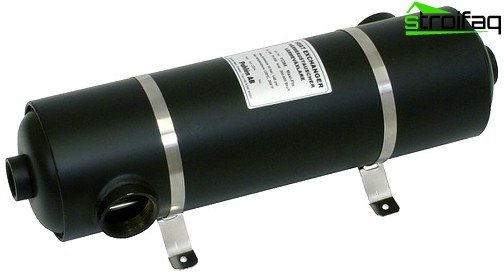
Heat exchanger for heating pool water
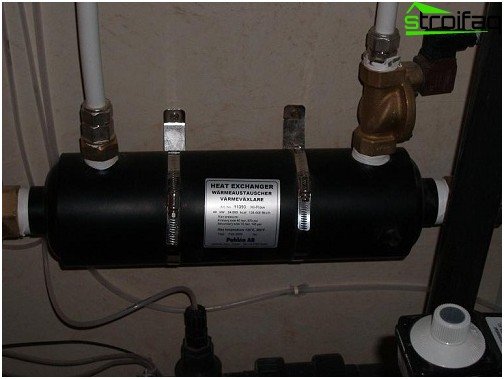
Heat exchanger in operation
Advantages of heat exchangers:
- significant cost savings
- Ease of controls
- high power
Disadvantages:
- prolonged heating of water
Solar collector (heliosystem)
The sun is an inexhaustible source of energy, they just tamed it very recently and immediately found application – they began to heat houses, apartments, warehouses and finally reached the pools.
Of course, the water in the pool itself can be heated under the rays of the scorching sun, but what if your pool is under a canopy or indoors? Then the sun goes to you!
Heliosystems or solar collectors are modules of cones, tubes or screens that receive rays. Each module individually can heat up to 30 cubic meters. meters of water, so the larger the volume of your pool, the more modules you need.
The principle of the collector: the sun’s rays, falling on the collector, which is usually black, are completely absorbed by it. The coolant inside the collector heats up to 140 degrees, and after that the circulation pump starts, which is located in the storage tank. Naturally, the water in it almost instantly becomes hot and can be used both for the pool and for heating and hot water supply at home.
There are such models of collectors in which sensors and an automatic three-way valve are built-in, with the help of which water is automatically sent to the heat exchanger. When the desired temperature is reached, water will pass by the heat exchanger, gradually cooling. And having reached its minimum value (it is set by the pool owner), the water will again flow into the heat exchanger and the system will start again.
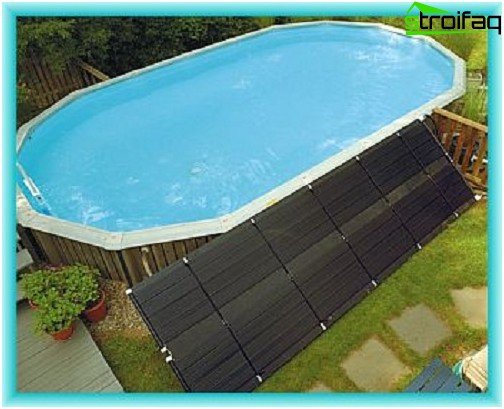
solar collector
Advantages of solar collectors:
- fast heating of water
- convenient control system
- multivariance of use: for space heating, for heating water in a pool, for supplying a house with hot water
Disadvantages:
- in cloudy weather, the collector efficiency decreases, thereby reducing the heat transfer coefficient
Heat pumps: power and speed
Heat pumps are a new and rather unpopular (yet) way for Russia to heat water in the pool. The lack of interest from buyers is simply explained – the high price for this type of heater.
Heat pumps operate on the principle of multi-stage heat transfer from different coolants with the help of condensate, compression of different gases, etc..
After treatment, domestic and industrial effluents, heat of thermal and groundwater, water of lakes, rivers, heat that is emitted during flue gas treatment and generally any heat sources whose temperature is at least one or two degrees higher than the initial heat source can be used pool water.
Principle of operation: working fluid is pumped through an external pipeline underground, using a circulation pump, for example, a mixture of water and antifreeze. At the outlet of the pipe, this liquid becomes several degrees warmer due to the temperature of the soil. After this, the mixture is sent to a heat exchanger (evaporator) where it gives its heat to the refrigerant, which instantly boils (it is enough for it to be barely warm water) and turns into steam. This vapor enters the compressor, which compresses it to 20-25 atmospheres. During this process, a sharp increase in temperature to 55 degrees.
It is this energy that is subsequently directed to heating a house or heating water in a pool.
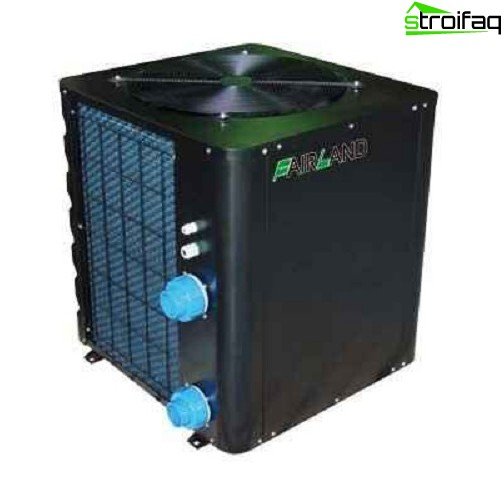
Heat pump
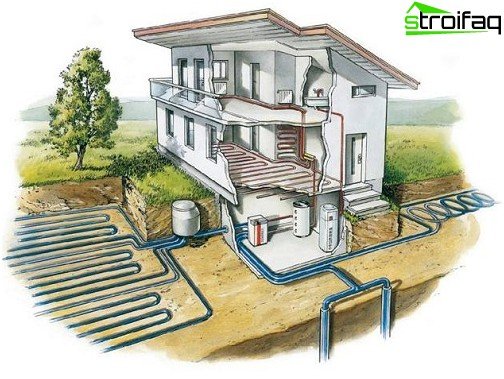
Layout of elements of a water heating system using a heat pump
This system works in a vicious circle: when the working fluid and refrigerant fulfill their purpose, they, having passed through the cooling stages, meet again to start the cycle in a new way. Thus, it turns out that the bulk of the energy spent on the compressor itself.
The power of the heat pumps allows not only to warm the pools, but also to provide huge cottages with an area of up to 300 square meters with heat. meters.
Advantages of heat pumps:
- high power
- fast water heating and space heating
- the use of free energy sources (heat of the earth, water, wastewater, etc.)
Disadvantages:
- high price
Well, now you know how to heat the pool and with what it can be done. It remains only to weigh the pros and cons and make the right choice. Good luck in the construction and repair!



